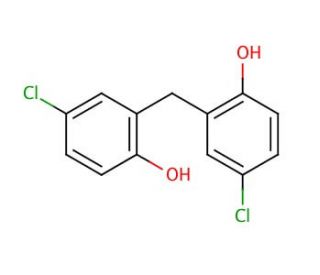

Dichlorophen (CAS 97-23-4)
QUICK LINKS
Dichlorophen is a synthetic chemical compound characterized by its bisphenolic structure, with two chlorophenol groups linked through a central carbon, which enhances its efficacy as both a fungicide and bactericide across various applications. The specific mechanisms by which dichlorophen operates involve disruption of microbial cell membrane integrity and inhibition of enzyme activities crucial for microbial metabolism. In microbial cells, dichlorophen targets the lipid components of cell membranes, altering their permeability and leading to leakage of essential intracellular components which culminates in cell death. This action makes it particularly effective in controlling the growth of fungi and bacteria in non-medical environments such as water systems and agricultural sites. In research, dichlorophen has been extensively used to study biofilm formation and the inhibition of microbial growth on different substrates, providing insights into its potential application for controlling microbial contamination and biofouling in industrial processes. Furthermore, its impact on various enzymatic systems within microorganisms has been a focus, helping to explain the pathways through which microorganisms respond to chemical stressors, thereby contributing to the broader understanding of microbial resistance mechanisms and the development of strategies to mitigate these adaptations in industrial and environmental settings.
Dichlorophen (CAS 97-23-4) References
- Development of zerovalent iron and titania (Fe0/TiO2) composite for oxidative degradation of dichlorophene in aqueous solution: synergistic role of peroxymonosulfate (HSO5-). | Bibi, N., et al. 2022. Environ Sci Pollut Res Int. 29: 63041-63056. PMID: 35445919
- Efficient Oxidation of Paracetamol Triggered by Molecular-Oxygen Activation at β-Cyclodextrin-Modified Titanate Nanotubes. | Zhou, Y., et al. 2022. Chem Asian J. 17: e202200352. PMID: 35470547
- Experimental and theoretical study on Fe(VI) oxidative degradation of dichlorophen in water: Kinetics and reaction mechanisms. | Fei, Y., et al. 2022. Environ Pollut. 306: 119394. PMID: 35525513
- Molecular fingerprints of polar narcotic chemicals based on heterozygous essential gene knockout library in Saccharomyces cerevisiae. | Guan, M., et al. 2022. Chemosphere. 308: 136343. PMID: 36087727
- Interpreting the degradation mechanism of triclosan in microbial fuel cell by combining analysis microbiome community and degradation pathway. | Liu, Q., et al. 2023. Chemosphere. 321: 137983. PMID: 36739987
- Repurposing of antiparasitic drugs against the NS2B-NS3 protease of the Zika virus. | Pant, S. and Jena, NR. 2023. J Biomol Struct Dyn. 1-13. PMID: 37747074
- CuCeTA nanoflowers as an efficient peroxidase candidate for direct colorimetric detection of glyphosate. | Jiang, C., et al. 2023. J Mater Chem B. 11: 9630-9638. PMID: 37750214
- Electrooxidation of chlorophene and dichlorophen by reactive electrochemical membrane: Key determining factors of removal efficiency. | Zhang, K., et al. 2024. Environ Res. 241: 117612. PMID: 37951380
- Two-dimensional metal-organic framework nanozyme-mediated portable paper-based analytical device for dichlorophen assay. | Chang, J., et al. 2024. Biosens Bioelectron. 255: 116271. PMID: 38583355
- 6PPD-quinone affects the photosynthetic carbon fixation in cyanobacteria by extracting photosynthetic electrons. | You, X., et al. 2024. Innovation (Camb). 5: 100630. PMID: 38800352
Ordering Information
| Product Name | Catalog # | UNIT | Price | Qty | FAVORITES | |
Dichlorophen, 50 g | sc-255083 | 50 g | $77.00 |
